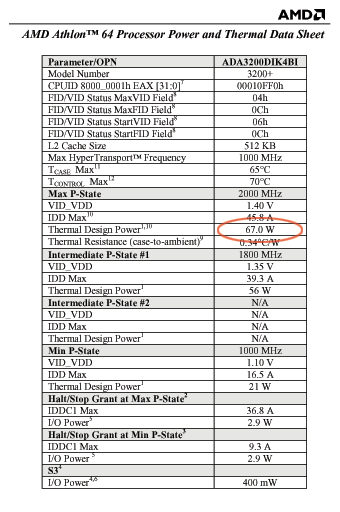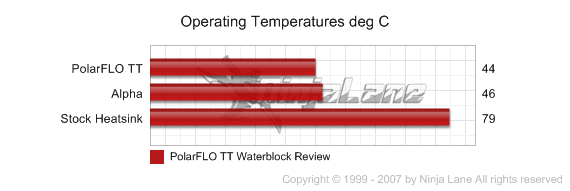After careful consideration I have decided to transfer all hardware review activities to a new domain. I purchased Hardwareasylum.com in 2012 and have been working hard to build a new and improved Ninjalane on that domain. If you are reading this you have reached one of the archived articles, news, projects and/or reviews that were left behind during the site migration.
Please update your bookmarks and be sure to visit the new and improved Ninjalane at Hardwareasylum.com
PolarFLO TT Waterblock Review
Author: Dennis Garcia
Published: Monday, June 13, 2005
Benchmarks
The PolarFLO TT is designed to fit all socketed processors that utilize a heatspreader such as the Intel P4-478/775, and AMD K8. Here is an overview of the system and testing methodology.
The system as it was tested
Soltek SL-K8TPro-939
Athlon64 3200+ 512KB L2 Cache 939 ADA3200DIK4BI
PolarFLO TT 2-barb configuration
Alpha PAL8150A using a Sunon KD1208PTB2 Fan
Stock AMD Heatsink
The watercooling system consisted of a Hydor L30 pump, Black Ice Extreme radiator, Sunon 120mm fan (running 7v), and a small reservoir for water storage and air collection. 1/2" I.D. hose was used throughout with minimum hose lengths used whenever possible.
CPUCool was used to obtain and record system temperature information and a game of Quake 3 provided the processor usage.
Athlon64 3200+ 512KB L2 Cache 939 ADA3200DIK4BI
PolarFLO TT 2-barb configuration
Alpha PAL8150A using a Sunon KD1208PTB2 Fan
Stock AMD Heatsink
The watercooling system consisted of a Hydor L30 pump, Black Ice Extreme radiator, Sunon 120mm fan (running 7v), and a small reservoir for water storage and air collection. 1/2" I.D. hose was used throughout with minimum hose lengths used whenever possible.
CPUCool was used to obtain and record system temperature information and a game of Quake 3 provided the processor usage.

Editors note: Even though the Windows XP task manager reported 100% processor usage we could never attain a 100% of the rated heat output as documented by AMD (see below)
when using Quake 3 as a basis for that heat production. Knowing this the game was played until the maximum temperature was attainted and stabilized, or when the round was over.
Other things to consider when judging software induced heat output.
a) Clock throttling by the processor at high temperatures.
b) Normal software isn't designed to produce maximum heat output.
c) Variances of cooling temperature.
d) Variances in CPU load.
e) Inaccuracies in thermal diode readouts.
Of course the list goes on..
My testing methodology is aimed to provide a real world look into this heatsink given the test system provided.
a) Clock throttling by the processor at high temperatures.
b) Normal software isn't designed to produce maximum heat output.
c) Variances of cooling temperature.
d) Variances in CPU load.
e) Inaccuracies in thermal diode readouts.
Of course the list goes on..
My testing methodology is aimed to provide a real world look into this heatsink given the test system provided.
Default

A C/W rating can quickly be calculated using this formula.
C/W = (CPU temp - Ambient temp)/(Variance(%) * CPU Watts)
Allowed variance for this test = 80%
CPU Watts = 67W
0.35 C/W = (44C - 25.5C)/(.8(67W))
C/W = (CPU temp - Ambient temp)/(Variance(%) * CPU Watts)
Allowed variance for this test = 80%
CPU Watts = 67W
0.35 C/W = (44C - 25.5C)/(.8(67W))
Overclocked
For this next test the FSB was cranked up to 245Mhz and the test was re-run.

To calculate a new C/W rating for this test we will need to factor in the increased processor
wattage. The formula and constants for this are listed below.
ocC/W = dCPU Watts * (ocMhz / dMhz) * (ocVcore / dVcore)2
ocMhz = 2450
dMhz = 2000
ocVcore = 1.6
dVcore = 1.39
The variance still applies for our C/W calcuation
Allowed variance for this test = 80%
CPU Watts = W
0.33 C/W = (54C - 25.5C)/(.8(109W))
ocC/W = dCPU Watts * (ocMhz / dMhz) * (ocVcore / dVcore)2
ocMhz = 2450
dMhz = 2000
ocVcore = 1.6
dVcore = 1.39
The variance still applies for our C/W calcuation
Allowed variance for this test = 80%
CPU Watts = W
0.33 C/W = (54C - 25.5C)/(.8(109W))
Benchmark Conclusion
For these benchmarks we opted to run the PolarFLO TT in a 2 barb configuration instead of the enthusiast ready 3-barb variation. The change does have a slight impact on overall performance though tends to only effect temperature spikes by reducing their frequency. Much to our surprise the Alpha did post a better thermal temperature under the overclocked conditions.
Keep in mind these calculations are provided for demonstration purposes only and may not reflect the actual lab tested C/W rating, but I think I'm close
Keep in mind these calculations are provided for demonstration purposes only and may not reflect the actual lab tested C/W rating, but I think I'm close

